Situation
So I'm trying to make a UIScrollView that is basically a menu navigation bar that a user can navigate by swiping between menu items, where there are pages vertically laid out, and sub-pages horizontally laid out. Mockup: 
The way I'm doing this is by creating a UIScrollView whose frame is the size of one UILabel, and I have isPagingEnabled set to true. I then tried adding a UIStackView, with each row indicating a page, and the contents of each row being a sub-page. I set the scrollView.contentSize to be the size of the UIStackView. The problem is that all my label's frames are zeros all through and the UIScrollView doesn't work.
:/
I really wanted to avoid getting help as I felt like I could do this by myself but I've spent two days on this and I've lost all hope.
Code
Here is the code where I add the labels. It's called upon the scrollview's superview's init (because the UIScrollView is in a custom UIView I call crossNavigation View).
private func addScrollViewLabels() {
//Get Max Number of Items in a Single Row
var maxRowCount = -1
for item in items {
if (item.contents.count > maxRowCount) {maxRowCount = item.contents.count}
}
self.rowsStackView.axis = .vertical
self.rowsStackView.distribution = .fillEqually
self.rowsStackView.alignment = .fill
self.rowsStackView.translatesAutoresizingMaskIntoConstraints = false
self.scrollView.addSubview(rowsStackView)
for i in 0 ..< items.count {
let row = items[i].contents
let rowView = UIView()
self.rowsStackView.addArrangedSubview(rowView)
var rowLabels : [UILabel] = []
//First Label
rowLabels.append(UILabel())
rowView.addSubview(rowLabels[0])
NSLayoutConstraint(item: rowLabels[0], attribute: .leading, relatedBy: .equal, toItem: rowView, attribute: .leading, multiplier: 1.0, constant: 0.0).isActive = true
NSLayoutConstraint(item: rowLabels[0], attribute: .top, relatedBy: .equal, toItem: rowView, attribute: .top, multiplier: 1.0, constant: 0.0).isActive = true
NSLayoutConstraint(item: rowLabels[0], attribute: .bottom, relatedBy: .equal, toItem: rowView, attribute: .bottom, multiplier: 1.0, constant: 0.0).isActive = true
NSLayoutConstraint(item: rowLabels[0], attribute: .width, relatedBy: .equal, toItem: containerView, attribute: .width, multiplier: 0.55, constant: 0.0).isActive = true
//Middle Labels
for j in 1 ..< row.count {
rowLabels.append(UILabel())
rowView.addSubview(rowLabels[j])
//Stick it to it's left
NSLayoutConstraint(item: rowLabels[j], attribute: .leading, relatedBy: .equal, toItem: rowLabels[j-1], attribute: .trailing, multiplier: 1.0, constant: 0.0).isActive = true
//Stick top to rowView
NSLayoutConstraint(item: rowLabels[j], attribute: .top, relatedBy: .equal, toItem: rowView, attribute: .top, multiplier: 1.0, constant: 0.0).isActive = true
//Row Height is equal to rowView's Height
NSLayoutConstraint(item: rowLabels[j], attribute: .height, relatedBy: .equal, toItem: rowView, attribute: .height, multiplier: 1.0, constant: 0.0).isActive = true
//rowLabels[j].width = containerView.width * 0.55 (so other labels can peek around it)
NSLayoutConstraint(item: rowLabels[j], attribute: .width, relatedBy: .equal, toItem: containerView, attribute: .width, multiplier: 0.55, constant: 0.0).isActive = true
}
//lastLabel.trailing = rowView.trailing
NSLayoutConstraint(item: rowLabels[row.count-1], attribute: .trailing, relatedBy: .equal, toItem: rowView, attribute: .trailing, multiplier: 1.0, constant: 0.0).isActive = true
}
//Constraints for stack view:
//rowsStackView.height = scrollView.height * items.count
NSLayoutConstraint(item: rowsStackView, attribute: .height, relatedBy: .equal, toItem: scrollView, attribute: .height, multiplier: CGFloat(self.items.count), constant: 0.0).isActive = true
//rowsStackView.height = scrollView.height * items.count
NSLayoutConstraint(item: rowsStackView, attribute: .leading, relatedBy: .equal, toItem: containerView, attribute: .leading, multiplier: 1.0, constant: 0.0).isActive = true
NSLayoutConstraint(item: rowsStackView, attribute: .top, relatedBy: .equal, toItem: scrollView, attribute: .top, multiplier: 1.0, constant: 0.0).isActive = true
NSLayoutConstraint(item: rowsStackView, attribute: .width, relatedBy: .equal, toItem: containerView, attribute: .width, multiplier: 1.0, constant: 0.0).isActive = true
self.scrollView.contentSize = rowsStackView.frame.size
}
